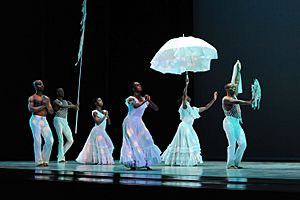Jazz dance facts for kids


Jazz dance is a lively and energetic dance style that first appeared in America in the early 1900s. It started as a social dance among African Americans, with roots in traditional African dances. Over time, jazz dance grew from a street dance into a popular style performed on stage. Like many other dance and music forms, it shows the strong African influence on Western culture.
The Story of Jazz Dance
The name "jazz dance" was first used to describe dances done to the exciting new jazz music of the early 20th century. But its true beginnings come from the dances brought by enslaved people from Africa to America. Back then, "jazz dance" meant any dance performed to jazz music. This included popular styles like tap dance and the jitterbug. A key part of early jazz dance was its focus on improvisation, meaning dancers made up steps as they went along.
From Social Dance to Stage Performance
Jazz dance started as a fun way for people to dance socially to jazz music. But it quickly grew into a special type of stage dancing. This meant it became a performance art, seen in theaters and shows.
Today, jazz dance is a very important part of training for stage dancers. Organizations like the ISTD (Imperial Society of Teachers of Dancing) teach jazz dance as part of their 'Modern Theatre' programs. The IDTA (International Dance Teachers Association) also includes it in their 'Theatre Branch' studies. Most professional stage dancers will have learned jazz dance as part of their training. Even modern ballet has been influenced by the energy and style of jazz dance.
Images for kids
See also
 In Spanish: Jazz (baile) para niños
In Spanish: Jazz (baile) para niños


